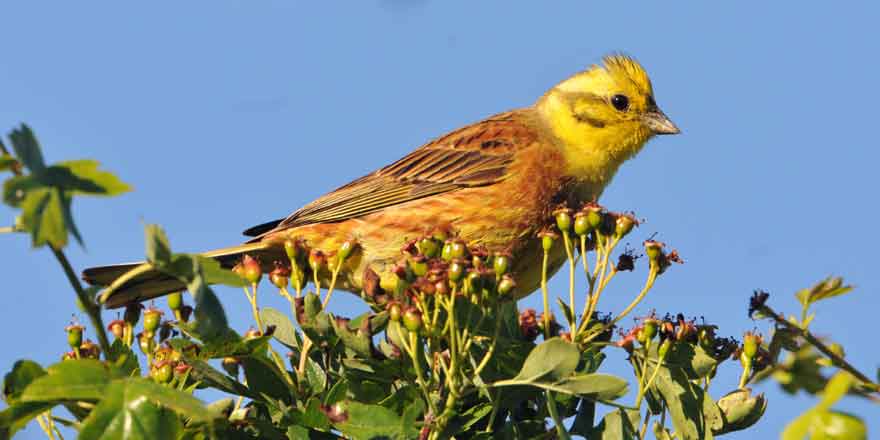
Birds of Clare Island: Yellowhammer
22 August 2020On Day 8 of Heritage Week we introduce a species that is now extinct on Clare Island, featuring in New Survey of Clare Island, vol. 9: Birds.
The ninth volume in the New Survey of Clare Island series focuses on the birds of Clare Island and is being released on 17 August as part of Heritage Week. Join us during Heritage Week and learn about some of the many birds that populate the island.
Today, you can read the entry on the Yellowhammer as it appears in Chapter Two of New Survery of Clare Island, vol. 9: Birds. Chapter Two contains an inventory of the birds of Clare Island, and this is compared with the findings of the first survey conducted during 1909–11. The list comprises records that span the period from 1887 to 2018.
Yellowhammer Emberiza citrinella Linnaeus
Once abundant; this species is now extinct on Clare Island.
Ussher (1912) described the yellowhammer as ‘one of our commonest resident birds’ and was present ‘all over Clare Island from March to September’. However, by April 1945 only three were found by Barlee and Ruttledge (1945). None has been seen since. The yellowhammer has also disappeared from other Irish islands including Cape Clear and Rathlin Island (Ruttledge 1966; Hutchinson 1989; Kelly unpublished data). These changes in the status of insular species—as well as ‘northern and western Ireland over the last 40 years’—are probably due to the ‘almost complete loss of arable farming’ (Balmer et al. 2013).
Image credits: R.T. Mills
About the book:
Explore Clare Island’s avifauna, including the seabirds, land birds and waterbirds, and investigate the curious absence of breeding rooks from the island. This volume features a systematic list comprised of records of bird sightings that stretch from 1887 to 2018. The result of almost 20 years of fieldwork, it is an invaluable source for future monitoring of birds on Clare Island and beyond.
The first Clare Island Survey of 1909–11 was the most ambitious natural history project ever undertaken in Ireland and the first major biological survey of a specific area carried out in the world. The ‘Birds’ paper included in that survey was written by Richard J. Ussher and was based on fieldwork conducted on the island between 1909 and 1911. Ussher’s ‘Aves’ paper, however, also summarised details of the avifauna of a wider area in the west of Ireland—mainly the Counties of Galway and Mayo—a theme that was revisited several times by the late Major Robert F. Ruttledge. The current ‘Birds’ volume focuses exclusively on Clare Island and applies modern methods of census.
Buy the book here.
About the project:
The New Survey of Clare Island is a unique multidisciplinary project, the overall aim being to assess the environmental changes that have taken place over the last hundred years on Clare Island. Together with Robert Lloyd Praeger’s first Clare Island Survey, the New Survey provides an invaluable body of research informing future conservation of natural and built heritage of Ireland and Europe.



